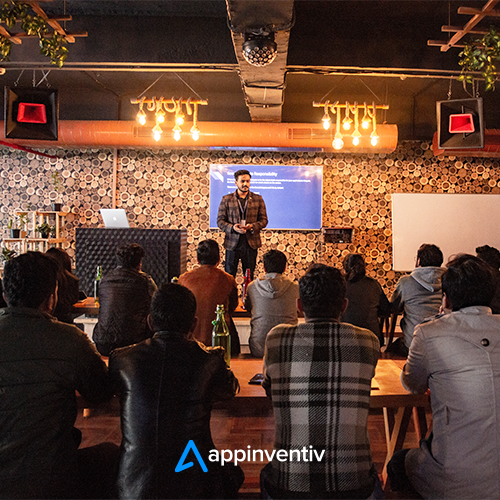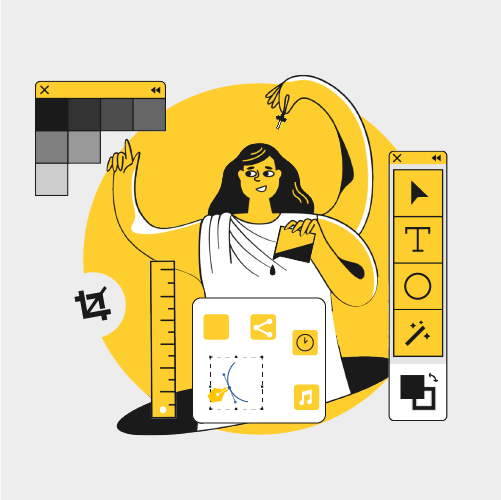“Every mobile application becomes successful through its functionality, code, and calculations, regardless of how it looks and works”, this sounds like an absolute fluke, I agree.
Nowadays, when we talk about mobile applications there is an immense need for an exceptional UI and UX as much as a perfect backend code. UI/UX and visuals are the reason why some mobile applications become an instant hit in the market and some are never downloaded in the first place.
“Good design is like a refrigerator—when it works, no one notices, but when it doesn’t, it sure stinks.” –Irene Au, Damian Jolley, UI Designer
Being a part of the mobile app development industry we realize that mobile app stores provide the space for displaying screenshots and videos of your applications so the users can have a quick glance at the amazing user interface that your app offers and be tempted into downloading it. Remember, nobody is playing the basic snake game or working on a grayscale rudimentary calculator anymore.
So, what makes your mobile application visually and functionally appealing is the UI and UX of the application.
These acronyms uphold the performance of your mobile application, but what do they actually mean? UI is the User interface, and UX stands for User Experience. For the fundamentals of it, the mobile app design steps are more concerned with user retention, which is experience-based and more subjective, whereas the UI design development process focuses on the visuals and graphics of an app. UI is a sub-part of UX in a Venn.
Although UI/UX design is an art, the mobile application design process of creating the graphics of an application is more systematic and technical than Art.
What is the Mobile App Design Process?
The mobile app design process is an ongoing procedure that comprises the creation of a user interface(UI) and user experience(UX). UI/UX designers ideate, define and create the app’s flow and structure to make the trendiest choices from colors to fonts to make an enticing and usable app by following the custom application design process steps.
We, at Appinventiv, follow a series of mobile app design process steps to create some of the most enticingly designed apps. The entire process of designing the mobile application’s interface can be broken down into 3 major phases:
- Planning
- UX Design/Wireframing
- Visual Design
Phase 1: PLANNING

Define the Problem
The first step to a mobile app UI design process at Appinventiv involves problem definition. It is a statement to address what issue is being solved by the app you’re making. For instance, my next mobile app is going to address the issue of difficulty in searching for the various courses and workshops available in my city. Similarly, a value proposition is a statement that explains what this app does. For instance, this app helps you in finding all the relevant courses and workshops around your city.
Extensive Market Research
At Appinventiv, market research is carried out in the form of a competitor analysis. It consists of studying what the competitors are doing and understanding how well their market strategies are working out. Market research gives a hands-on idea about the USP of mobile applications made in the same domain by your direct competitors. It also let you in on the details of the negative and positive points of the competitor’s applications.
Identify Target Audience
The mobile app design and development changes according to the final functionalities of the app and depending on behavior and needs of the final users. For instance, an app aimed at children as target users will have smoother edges and a softer color palette as compared to a strictly business centered mobile application. So identification of the end-user puts a great impact on the final UI of the mobile application.
At Appinventiv, user persona and stories are created to help the designers in corroborating their end–users core requirements and understanding their behavior.
User personas and user stories are made to answer the following questions:
- What are the user demographics?
- What is the goal of this application in relation to the end-user?
- What is the motivation of this user to use this particular kind of application?
- What is the frustration that is caused by other such applications and how we are targeting those points in this application?
- How this application meets the needs of the end-user?
Make an Information Architecture Map
The next step is to map down the key features to be incorporated into the mobile application. The mobile information architecture map can be in the form of a flowchart, hierarchical design, or a scamper diagram. The aim is to successfully interrelate every feature that is being listed down. At Appinventiv, this document helps in the conveyance of all the information about the application features in a simple unidirectional way.
Phase 2: WIREFRAMING

Never Miss Wireframing
The next phase in mobile app UI design process is creating a wireframe for your mobile app. A wireframe, in a layman’s language, is a visual representation of the interactive design crafted above. It provides only the main elements to be taken into consideration. Wireframing help in deciding which interface elements will appear on the main page, based on the priority and interactivity of the design. While many people use Sketch or Omnigraffle, we still rely on Photoshop to build wireframes.
Wireframing can be done as a Low Fidelity Mockup or a High Fidelity Mockup, depending upon the customer‘s needs solely.
The basic idea behind wireframing is to make an information structure and create an interaction pattern out of it.It is the first step in which the mobile app UX design process gets materialized and can be taken forward.
At Appinventiv, this phase holds immense importance to validate the idea from the design point of view and make the client gets clarity of the idea of what the MVP product will be like.
Prototyping is Important
After the wireframe of the application is finalized, at Appinventiv, it is made into a clickable prototype. This is done to get an idea about the user intuitiveness or the UX of the application. Platforms such as Proto.io helps in building the primitive framework, which can be sent across a closed audience for real-time feedback about the UX. If there are any changes to be made, then the design is re-iterated by the design team and the decided changes are made and the app UX is finalized. It is an ardently important stage of mobile app development; prototyping can help a company raise funds prior to completion of the actual mobile application
Step 3: VISUAL DESIGN

Make Style Guides
For mobile app development process and the web app design process, visual language development is a very important step. Branding refers to the feel and theme of the entire application, which resonates in harmony with the brand logo and image in the market. A mood board is designed based on the color palette of the design theme and the feel it needs to convey.In the end, a style guide is formulated with the selected typography and color schemes. This makes the first step towards concrete designing of the UI of the mobile application. However, the UI is highly influenced by the design trends, and you need to stay updated with the app design trends at all times.
UI and Final Prototyping for Good
Designing the space, color, shapes, and movements of the elements put onto every page of the mobile application altogether makes up an amazing UI. A final prototype is made with all of the features incorporated into the app design and sent to the development team for further coding.
After this one iteration, an MVP is developed and validated and shared with the client. If any scope of change is required from the client’s end, it is performed in the final design of the mobile application. This process remains more or less the same for Android as well as iOS mobile application design process.
Wrapping Up!
No right product can be delivered in one try. The changing mobile app UI design trends, user preferences, emerging technologies, and other factors make it usual for a designing team to iterate their design repeatedly to make your mobility solution more market-fit. But this doesn’t mean it would be like a relay race on a circular track.
Of course, there is art in graphic designing, but when it comes to mobile app designing, it also includes a structure and series. If we go bigger in terms of functionality, this structure keeps getting more detailed and complex. You can also integrate motion design into your mobile application design process to make them come alive and enhance user experience. Similarly, many other things can be incorporated into the app as per the client‘s requirements like app gamification to increase user engagement.
Appinventiv provides top-notch product design services to deliver experiences that are ever-evolving. We offer multiple design sprint workshops to think broadly about user experience and act deep to craft brilliance altogether. We help businesses to stay at the forefront of technology disruptions and keep users centered in the entire design process.
For instance, we helped global brands like Dominos and Pizza Hut in redesigning their mobile app and delivering transformative UI/UX that helped them increase their conversion rates by 23% and 30% respectively.
FAQs
Q: What does the term “Design Thinking” means?
A: Design thinking is a collective term used to describe a set of cognitive, strategic, and viable processes which are used to design concepts. In layman’s terms, it is the human-centered approach to innovation while taking into account different aspects that will transform the way you develop products like the user’s core needs, creative ideas, technology, and prototyping.
Q: What are the latest key trends in the mobile app design process?
A: The trends in the mobile app design industry keep on changing with time. Currently, the latest key trends in the mobile app UI design are:
- Augmented and virtual reality
- Artificial intelligence
- SSO login
- Multi-directional navigation
- Animation
- Emoticons
- Liquid swipe and no button design
- Voice user interface and contactless interaction
Q: What are the mobile app UI design costs?
A: The mobile app UI design cost directly depends on two variables- the time to develop the application and the complexity of the app. Also, the design costs vary depending on the country you are getting it developed. For example, mobile app design services in the US cost more than what it costs in Europe, Asia, or Australia.



Fueling Success: Appinventiv's Role in Raising $950 Million in Funding for Clients - Real Stories
In the world of startups, where visions are grand and ambitions boundless, securing funding becomes pivotal for entrepreneurs. It becomes the quintessential key that unlocks the world of possibilities and transforms groundbreaking ideas into reality. However, securing funding is a daunting task for any business. While investors are constantly on the lookout for promising ventures,…

The Impact of Employee Training and Development
Do you want to know the secret of making your employees stay in your company? The answer lies in learning. According to LinkedIn, 94 percent of employees would stay with a company longer if they were given the opportunity to learn. But why? Encouraging new thinking with a solid training and development programme increases employee…

Appinventiv’s Cultural Twist - How to Recruit & Retain Talent in Lockdown
The outbreak of COVID-19 has impacted nations in an enormous way, especially the nationwide lockdowns which have brought social and economic life to a standstill. The global crisis has brought new urgency to some of corporate India’s long standing challenges, and that companies which act now to address these priorities and adopt the “next normal”…

















